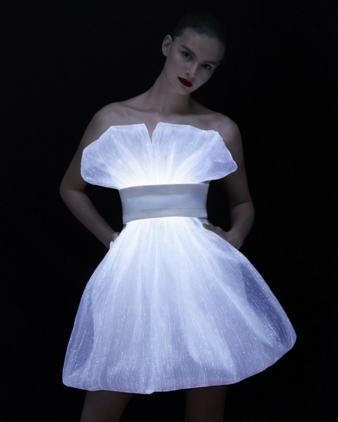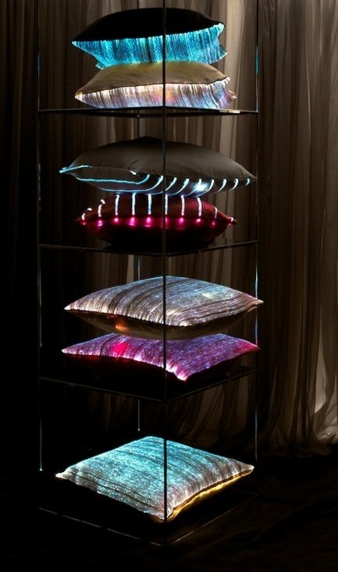01/06/2020 – How do smart textiles light or heat up? — auf Deutsch lesen
FLT GmbH – Future Lighting Technologies – knows how it’s done!
Textiles can do many things, but textile composites can do even more. Lighting, heating, switching and sensing, including all the electronics required – almost anything is possible.
If necessary, all these functions can be integrated in different layers and combined into a laminate about 1 mm thick. Exclusively in textile network, Björn Sobischek, Managing Director FLT, explains how it all works.
Lighting
Filaments known as optical fibres, made of PMMA or similar materials, can be built into textiles during production. Once woven in by the loom, these are connected to an LED that couples the light source into the PMMA light conductors. To emit the light, these conductors need to be activated. The quantity and thickness of the PMMA light conductors is variable and provides a fully illuminated surface. In the weft direction, the textile consists solely of optical light conductors to produce a pleasing ambient light with a delicately sparkling starlight effect. An alternative technical solution is to incorporate electrically conductive threads to which micro-LEDs are attached. On a weaving loom, the LEDs are all arranged in the same direction and produce individual points of light. The electrically conductive threads are connected to a rechargeable battery. The types of textile threads used vary by customer; options include not only polyester, Trevira CS, cotton and silk but also paper and genuine gold thread.
Heating
Conductive threads are incorporated into the textile in the weaving, knitting or other production process. Connected to a power source, electricity is supplied to the heating fibres and they heat up. For wearables, the maximum temperature is about 40 °C, while for a car seat it is up to about 65 °C and for technical applications it may be as much as 100 °C. Another way in which fabrics can be heated is through the use of non-woven fabrics. Here, slivers of iron, stainless steel, silver or carbon are incorporated at the manufacturing stage, so that after calendering, pressing and setting, they form a conductive unit. Once connected to a power source, they similarly produce a homogeneous heat across the entire surface of the fabric. A laminate consisting of a surface textile (with or without light) and a heated non-woven produces a composite material that may be as thin as 0.5 mm. The material is able to heat up very rapidly as a direct contact is created to the heated component beneath the surface.
On and off – even contactless
With wearables, the functions can be switched on and off by means of a button on the battery or power source, for example. On heated car seats and door heaters, the switch is generally hidden beneath the surface fabric. Electrical contacts for this purpose can be precisely positioned in the composite during the laminating process, with contact wires passing out of the composite to connect them to the electronic controller. Hence a finger pressing on the button can trigger an invisible switch through the surface.
The sensitivity of the switching unit can be set so that the presence of the finger is detected even before it touches the surface of the switch, and triggers activation of the switching process. In the automotive field, haptic feedback – a physical indication that a switch has been activated – is necessary so that the driver is informed that the required function has been activated without even needing to look at it. Tiny vibrators such as those used in mobile phones, for example, can be incorporated into the laminate for this purpose. Alternatively, the feedback motors might instead be built into an entirely different location; for example, feedback from a contactless window winder could be positioned at elbow level in the armrest. The possibilities are almost endless, so further exciting uses for smart textiles are anticipated!
“In addition to wearables, FLT GmbH covers two other fields – automotive, home and living,” says Björn Sobischek, FLT Director. “And we have just added the medical field, with further new possibilities of its own. Each division has its own quite particular requirements, so our new developments are always very project-specific.”





